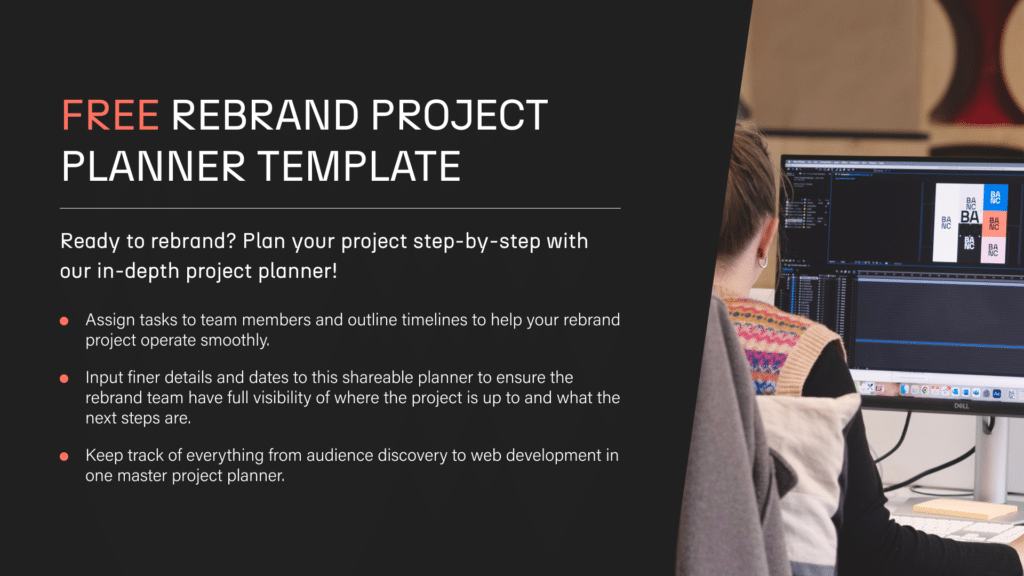The Complete Guide to Rebranding [with Project Planner Download]
There comes a time when your current direction will reach its logical endpoint. Whether it’s an outdated name and logo, a tone of voice that no longer speaks to your audience, or a mismatch between vision and values, then it sounds like you need to take a different tack – and that means rebranding.
Unfortunately, a fancy logo or a shiny new set of brand principles don’t just happen overnight. It’d be great if they did, but rebranding takes time, effort, research, false starts, restarts and a lot of conceptual elbow grease to properly pull off.
Thinking of breathing new life into your tired business, but not sure where to start? That’s perfectly OK. Rebranding is a tall order, one that won’t come to fruition with half measures and shoddy planning. Luckily, you’re in the right place. Over the course of this article, we’ll guide you through everything you need to know about rebranding, before you mobilise a talented team that’ll help carry out your vision.
Quick Links
- What is rebranding?
- Examples of successful rebrands
- How to plan your rebrand
- Creating your rebrand strategy
- Launching the rebrand
What is rebranding?
Rebranding is the process of changing a company’s image by creating a new name, logo, visual identity or strategy – so it can forge a differentiated brand that consumers, employees, stakeholders and investors will associate with this newly-rebranded company.
Examples of successful rebrands
There’s no shortage of brands who have refreshed, revitalised and re-jigged themselves in ways that got people buzzing about them all over again. Here’s a few of our favourites…
Dunkin’
In 2019, Dunkin’ dropped the Donuts from its name, and everything from its logo and packaging to its physical stores and advertising reflect the shortened moniker.
Why it works:
Simply put, it showed the brand was willing to get with the times. A lot of its customers were familiar with the new name from a previous tagline: “America Runs on Dunkin'”, and the Donuts aspect of the company was becoming increasingly obsolete as the brand continued to focus more on coffee.
Secondly, it shows that their name still carries weight. Their customers still happily identified it with the brand they know and love. If you’re planning on changing the name of your business entirely, or even just part of it, make sure the new name has something your audience can logically link to a brand they’ve already connected with.
Lego
Amidst huge debts and growing distaste among its child-friendly audience (kids are pretty fickle, after all), the toy titan needed some serious rebuilding. So that’s what they did, adding digital channels to connect with kids and parents alike, and gaining cultural clout once again through its films and other entertainment ventures.
Why it works:
Because it proves that even the biggest brands can still get lost in the shuffle if their strategy’s off. Nobody is exempt from disinterested audiences.
Dropbox
Originally a file-storage and file-sharing web service, the company rebranded in 2017 with a new tack. Since then Dropbox has made it its mission to connect teams and businesses together by offering a full suite of APIs, tools and integrations to facilitate greater collaboration.
Why it works:
Because it shows how effective and powerful conceptual design can be in a rebrand. To go along with its new approach, Dropbox redesigned their old logo. Rather than an opening box that shouts “store your stuff here”, the cleaner, simpler and more conceptually open logo was a really effective reflection of the wide, more collaborative scope it now caters towards.
Burger King
In December 2020, Burger King did away with their very 2000s logo. Logically, the new one is a reflection of the 20s, right? Well, not quite. The burger brand actually went in the opposite direction, unveiling a new logo that harked back to their 1969 – 1999 logo. It was a cleaner look than the busier 2000s-era emblem, but it was more than just a mere rehash…
Why it works:
Burger King’s out with the old, in with the even older had plenty of positives going for it. As well as a more refined appearance, the rebrand also saw a new monogram design, a colour palette based around natural earth tones, adaptable typography, and digital assets that combined the retro with the modern in ways that really clicked. Design is hugely powerful, and Burger King’s well-done rebrand emphasises that point perfectly.

How to plan your rebrand
Outline the scale of your rebrand
Of course, a rebrand doesn’t mean you have to overhaul everything from the ground up. This is what you’ll have to decide. Are you simply refreshing certain elements like your logo or your website, or are you completely changing your brand’s mission, values and target audience?
Assemble your team
A cracking team of colleagues who’ll pitch in with ideas, carry out any creative work and ultimately implement the rebrand goes without saying. But it’s a good idea to put the following people in the ranks:
- Someone with seniority to approve ideas and provide additional resources
- Someone who will determine what gets delivered and when
- A selection of creatives who’ll be responsible for the designing, writing, and development aspects of the rebrand
- A committee of stakeholders who can spot issues or offer alternative suggestions
Investigate your business’ vision and direction
What are the things that currently govern your brand? By delving into your company’s mission, vision and values, you’ll be able to understand the essence of what makes you special, the things it holds dear, and the reasons it exists. Don’t forget to look at your brand’s voice either. The words you choose should match the message you’re putting out to the world. With this foundation of info, you’ll be able to identify anything that needs changing as part of the rebrand.
Audience and market research
You’ll want to get the lay of the land with regards to your audience and competition. There’s a chance that you’re engaging with entirely different people from who you initially wanted to cater to, for example.
Look to your competition for inspiration too. How do you stand apart from them and does your value proposition differ? Who do you want to be more (or less) like? By looking at the rest of the market, you’ll be able to spot the approaches that are proving popular – and the approaches that aren’t – that you can then channel into your own rebrand.
Establishing the new concept of your brand
With your team assembled, audience and competition researched and everyone up to speed on your vision and values, you’re now ready to start building out your brand concept. A lot of this will depend on the extent of your rebrand of course, but your mission, tone of voice and visual style will more than likely undergo changes which you can then base your entire brand and strategy around.

Creating your rebrand strategy
The different elements of your rebrand will need to come together in a strategy that lets the company as a whole know which approaches are changing, the goals you plan to achieve, and the methods you’ll use to achieve these goals. It’ll also help your company’s creatives achieve the tone and look of the new brand.
Target audiences
Based on research you’ve carried out, creating audience personas means you can detail exactly the kind of person you want to be targeting. By representing this ideal customer (or customers) and understanding their likes, dislikes, pain points and even things like age and occupation, you’ll be able to align your messaging without making assumptions or guesswork about who you want to target.
Design
Here, you’ll lay out the design elements that your rebranded company will adhere to. Everything from the colours you’ll use (and ones you won’t) including their colour values; typefaces and fonts (and their sizes, styles and usages) and any image guidelines to stick to across your collateral.
Brand name and logo
To ensure consistency whenever it’s used, your logo needs to play by specific rules too. In this part of the strategy, detail any specification about its size, where it can be used and how much negative space should be around it – as well as how it shouldn’t be used too.
Tone of voice
Along with the visual elements, the tone you want your messaging to take, whether it’s on your website or across social media, should be made clear. Is your brand friendly and relatable? Is it aspirational? Is it catering to an audience of a certain age? The tone of voice details the language you’ll use to fully reflect your mission and messaging – including specific words you will and won’t use from now on.
Marketing channels
Speaking of messaging, here you’ll lay out all of the activity across every one of your chosen marketing channels in order to properly broadcast your products and services.
Launching the rebrand
Now you’re ready to press that shiny red launch button – internally and externally. Not everyone will have been involved on the rebrand project, and those that were involved have had to stay tight lipped for the time being, an internal launch gives the team a chance to explain the reasons for the rebrand – and of course show off all that hard work too!
Externally, creating a narrative that your customers can follow and understand why you’ve rebranded. You should also ramp up your channel activity so that your audience are aware of your new look too, leveraging social media, email marketing, press releases, print, TV and radio to shout about your brand as loudly as possible.
Of course, this all needs careful planning and thorough communication amongst the team, so that everything is fully co-ordinated on the big day. Things don’t simply stop once the rebrand has gone live either. There are a whole host of metrics you can analyse to see how successful your rebrand has been, so you can show senior leaders and stakeholders the true value your rebrand project has created for the company.
Download your free Complete Rebrand Project Planner Template

There’s a lot to weigh up when it comes to a rebrand. And that means planning and preparation is key. Lucky for you, we’ve created a rebrand project planner for you to download and stuff with all of your research, insights and plans as your rebrand moves from initial ideas to a huge, company-changing undertaking.
Download it here!
Don’t have the time to carry out a rebrand on your own? Team up with us instead! We’ll get to work revitalising your brand with fresh visuals, a tone of voice that speaks volumes, and a mission that truly captures what makes your brand unique. Head here for more info or touch base with us on 0345 459 0558.



